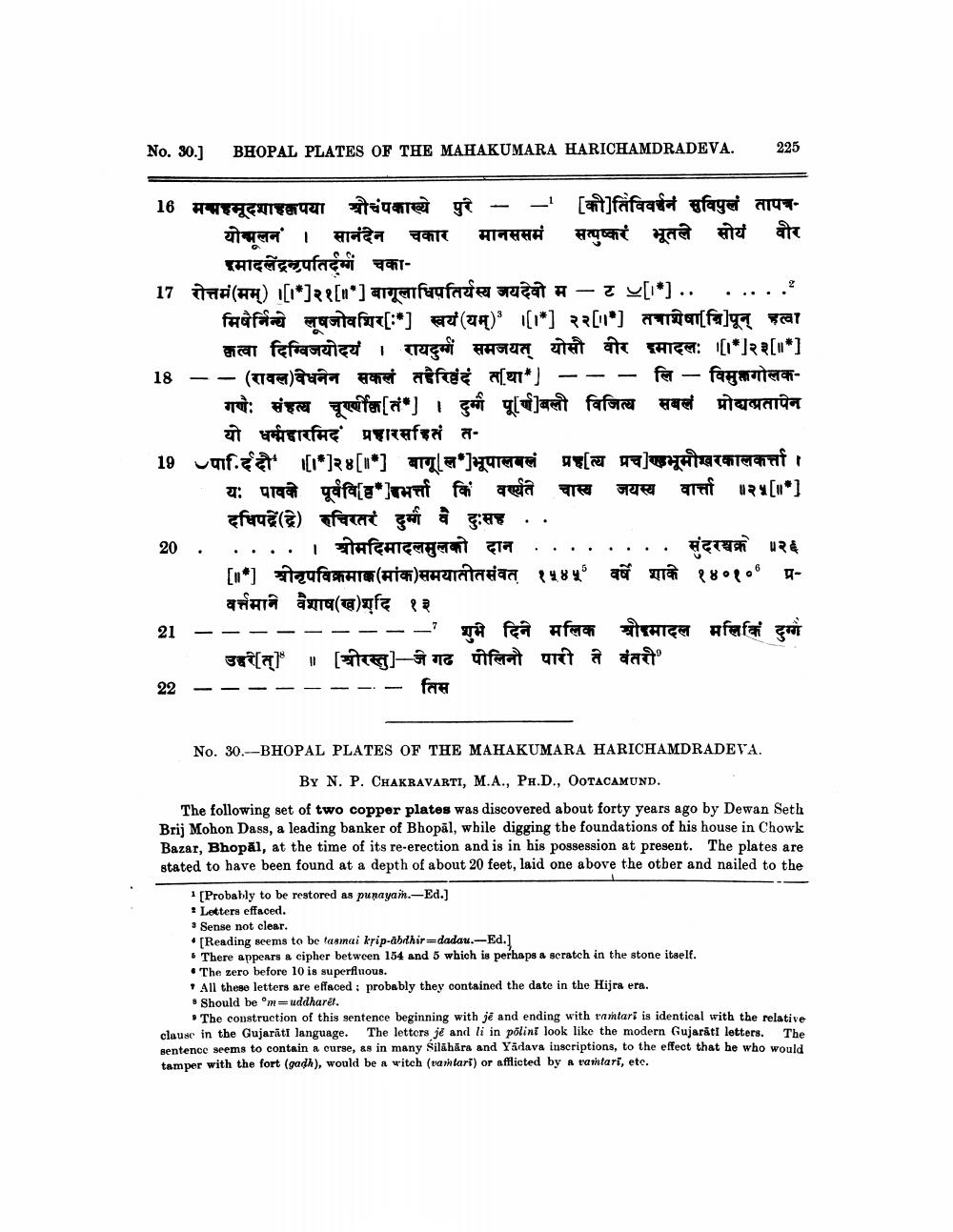________________
No. 30.]
16 ममहसूदमाहरूपया श्रोचंपकास्ये पुरे
18
BHOPAL PLATES OF THE MAHAKUMARA HARICHAMDRADEVA.
20
]
17 रोत्तमं (मम्) |[*]११[४] बागूलाधिपतिर्यस्य जयदेवो म ट मिषैर्निन्ये लूषजोवशिर [ : * ] स्वयं (यम् ) |[ । *] २२ [ । * हत्वा दिग्विजयोदयं । रायदुखी समजवत् बोसो वीर ( रावल) बेधनेन सकलं तर तथा
-
21
योन्मूलन' । सानंदेन चकार मानससम प्रमादद्रन्टपति चका
19 पादिदी' [*]२४ [ ॥ *] बागूल*] भूपालवलं पूर्ववि[द्य]भर्त्ता किं वर्ण्यते
22
[1] ..
तत्राशेषा[वि]पून् हत्वा मादलः [[1*]२२ [*]
लि
विमुक्त गोलक
गणैः । गये संहत्य पूर्वी [*] दुर्गा पू[] बलो विजित्य सबल प्रोद्यखतापेन यो धर्मद्दारमिद प्रहारसहितं त
१३
[को]तिविवर्धनं सुविपुलं तापचसत्पुष्करं भूतले सोयं वीर
7
-
-
1 [Probably to be restored as punayan. Ed.]
= Letters effaced.
यः पावके दधिपढ़ें (द्रे) रुचिरतरं दुर्ग वे दुःसह । श्रीमदिमादनमुलको दान
सुंदर
॥२५
[n*] श्रीनृपविक्रमाक्क (मांक) समयातीत संवत् १५४५० वर्षे शाके १४०९०° प्रवर्त्तमाने वैशाष (ख) दि
225
-
प्रह][ [य] प्रच] कभूमीवरकालकर्त्ता । चास्य जयस्य वार्त्ता ॥२५ [ ॥ * ]
शुभ दिने मलिक बोरमादल मलिकिं दु उचरे[त्]® • [ चीरस्तु जे गढ पोलिनी पारी से वंतरी"
तिस
No. 30.-BHOPAL PLATES OF THE MAHAKUMARA HARICHAMDRADEVA.
BY N. P. CHAKRAVARTI, M.A., PH.D., OOTACAMUND.
The following set of two copper plates was discovered about forty years ago by Dewan Seth Brij Mohon Dass, a leading banker of Bhopal, while digging the foundations of his house in Chowk Bazar, Bhopal, at the time of its re-erection and is in his possession at present. The plates are stated to have been found at a depth of about 20 feet, laid one above the other and nailed to the
3 Sense not clear.
[Reading seems to be tasmai krip-abdhir-dadau.-Ed.]
There appears a cipher between 154 and 5 which is perhaps a scratch in the stone itself.
• The zero before 10 is superfluous.
All these letters are effaced: probably they contained the date in the Hijra era.
8 Should be °m=uddharet.
The construction of this sentence beginning with je and ending with ramtari is identical with the relative clause in the Gujarati language. The letters je and li in polini look like the modern Gujarati letters. The sentence seems to contain a curse, as in many Silahāra and Yadava inscriptions, to the effect that he who would tamper with the fort (gach), would be a witch ( vaitari ) or afflicted by a rahtari, etc.




